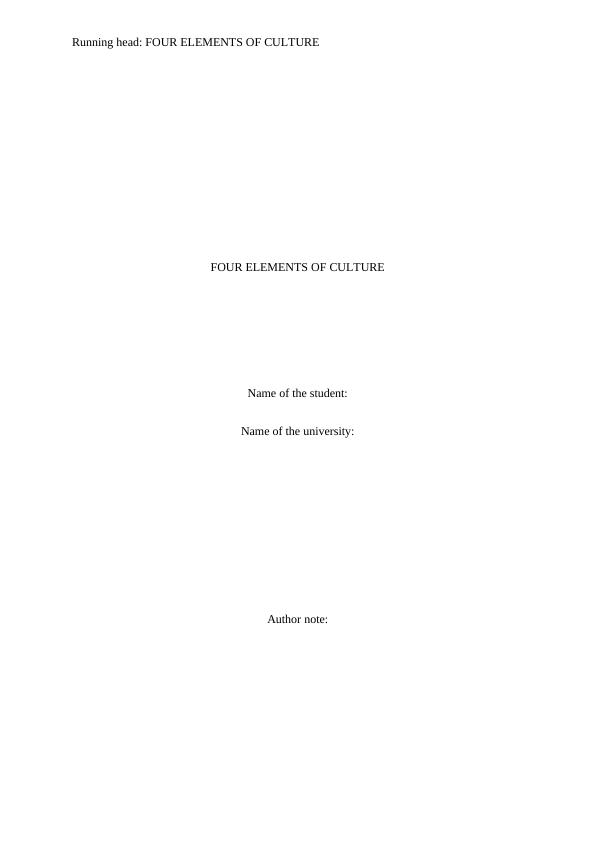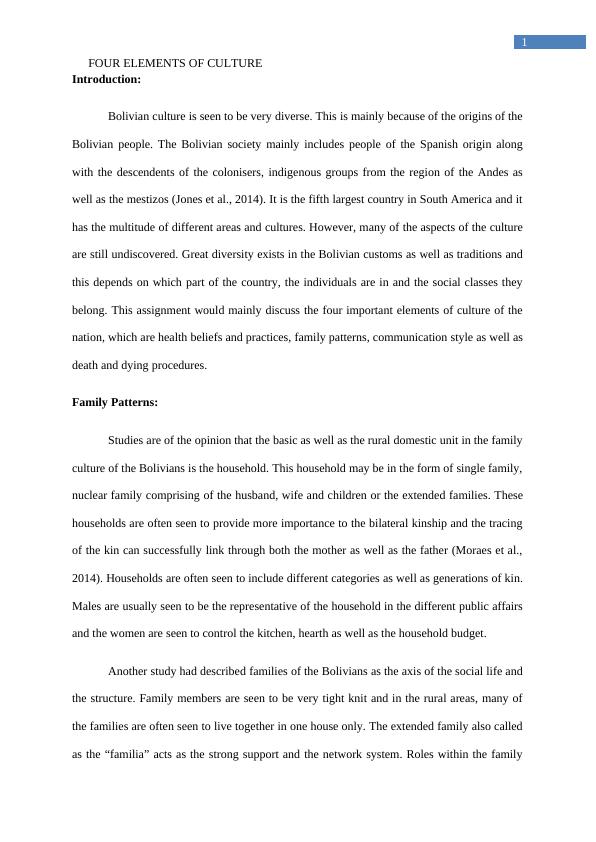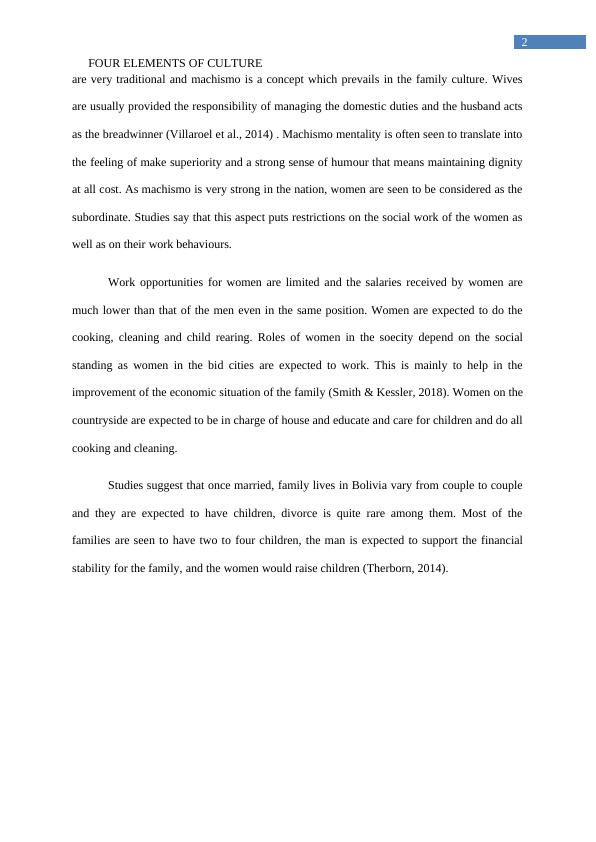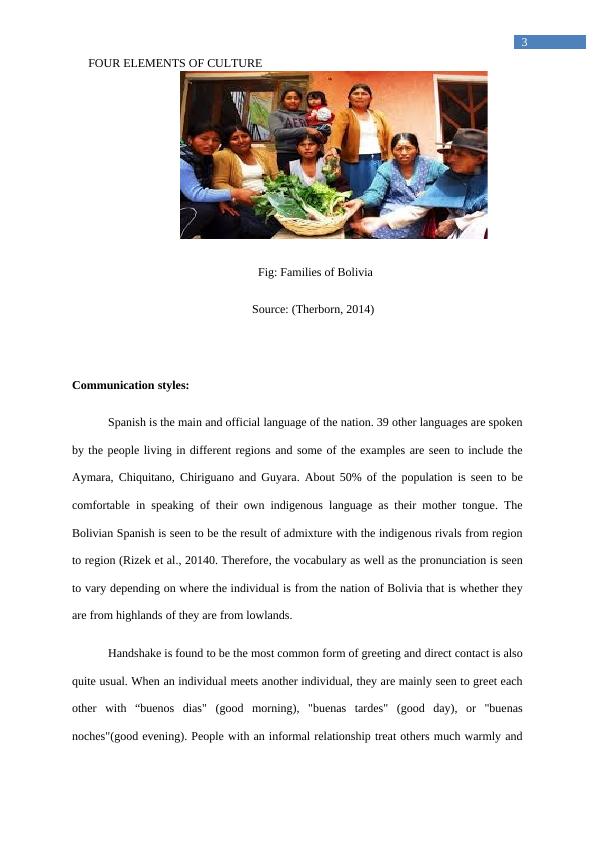HUCL1101 Role Concepts in Healthcare
13 Pages3180 Words70 Views
Role Concepts in Healthcare (HUCL1101)
Added on 2021-10-29
HUCL1101 Role Concepts in Healthcare
Role Concepts in Healthcare (HUCL1101)
Added on 2021-10-29
ShareRelated Documents
Running head: FOUR ELEMENTS OF CULTURE
FOUR ELEMENTS OF CULTURE
Name of the student:
Name of the university:
Author note:
FOUR ELEMENTS OF CULTURE
Name of the student:
Name of the university:
Author note:

1
FOUR ELEMENTS OF CULTURE
Introduction:
Bolivian culture is seen to be very diverse. This is mainly because of the origins of the
Bolivian people. The Bolivian society mainly includes people of the Spanish origin along
with the descendents of the colonisers, indigenous groups from the region of the Andes as
well as the mestizos (Jones et al., 2014). It is the fifth largest country in South America and it
has the multitude of different areas and cultures. However, many of the aspects of the culture
are still undiscovered. Great diversity exists in the Bolivian customs as well as traditions and
this depends on which part of the country, the individuals are in and the social classes they
belong. This assignment would mainly discuss the four important elements of culture of the
nation, which are health beliefs and practices, family patterns, communication style as well as
death and dying procedures.
Family Patterns:
Studies are of the opinion that the basic as well as the rural domestic unit in the family
culture of the Bolivians is the household. This household may be in the form of single family,
nuclear family comprising of the husband, wife and children or the extended families. These
households are often seen to provide more importance to the bilateral kinship and the tracing
of the kin can successfully link through both the mother as well as the father (Moraes et al.,
2014). Households are often seen to include different categories as well as generations of kin.
Males are usually seen to be the representative of the household in the different public affairs
and the women are seen to control the kitchen, hearth as well as the household budget.
Another study had described families of the Bolivians as the axis of the social life and
the structure. Family members are seen to be very tight knit and in the rural areas, many of
the families are often seen to live together in one house only. The extended family also called
as the “familia” acts as the strong support and the network system. Roles within the family
FOUR ELEMENTS OF CULTURE
Introduction:
Bolivian culture is seen to be very diverse. This is mainly because of the origins of the
Bolivian people. The Bolivian society mainly includes people of the Spanish origin along
with the descendents of the colonisers, indigenous groups from the region of the Andes as
well as the mestizos (Jones et al., 2014). It is the fifth largest country in South America and it
has the multitude of different areas and cultures. However, many of the aspects of the culture
are still undiscovered. Great diversity exists in the Bolivian customs as well as traditions and
this depends on which part of the country, the individuals are in and the social classes they
belong. This assignment would mainly discuss the four important elements of culture of the
nation, which are health beliefs and practices, family patterns, communication style as well as
death and dying procedures.
Family Patterns:
Studies are of the opinion that the basic as well as the rural domestic unit in the family
culture of the Bolivians is the household. This household may be in the form of single family,
nuclear family comprising of the husband, wife and children or the extended families. These
households are often seen to provide more importance to the bilateral kinship and the tracing
of the kin can successfully link through both the mother as well as the father (Moraes et al.,
2014). Households are often seen to include different categories as well as generations of kin.
Males are usually seen to be the representative of the household in the different public affairs
and the women are seen to control the kitchen, hearth as well as the household budget.
Another study had described families of the Bolivians as the axis of the social life and
the structure. Family members are seen to be very tight knit and in the rural areas, many of
the families are often seen to live together in one house only. The extended family also called
as the “familia” acts as the strong support and the network system. Roles within the family

2
FOUR ELEMENTS OF CULTURE
are very traditional and machismo is a concept which prevails in the family culture. Wives
are usually provided the responsibility of managing the domestic duties and the husband acts
as the breadwinner (Villaroel et al., 2014) . Machismo mentality is often seen to translate into
the feeling of make superiority and a strong sense of humour that means maintaining dignity
at all cost. As machismo is very strong in the nation, women are seen to be considered as the
subordinate. Studies say that this aspect puts restrictions on the social work of the women as
well as on their work behaviours.
Work opportunities for women are limited and the salaries received by women are
much lower than that of the men even in the same position. Women are expected to do the
cooking, cleaning and child rearing. Roles of women in the soecity depend on the social
standing as women in the bid cities are expected to work. This is mainly to help in the
improvement of the economic situation of the family (Smith & Kessler, 2018). Women on the
countryside are expected to be in charge of house and educate and care for children and do all
cooking and cleaning.
Studies suggest that once married, family lives in Bolivia vary from couple to couple
and they are expected to have children, divorce is quite rare among them. Most of the
families are seen to have two to four children, the man is expected to support the financial
stability for the family, and the women would raise children (Therborn, 2014).
FOUR ELEMENTS OF CULTURE
are very traditional and machismo is a concept which prevails in the family culture. Wives
are usually provided the responsibility of managing the domestic duties and the husband acts
as the breadwinner (Villaroel et al., 2014) . Machismo mentality is often seen to translate into
the feeling of make superiority and a strong sense of humour that means maintaining dignity
at all cost. As machismo is very strong in the nation, women are seen to be considered as the
subordinate. Studies say that this aspect puts restrictions on the social work of the women as
well as on their work behaviours.
Work opportunities for women are limited and the salaries received by women are
much lower than that of the men even in the same position. Women are expected to do the
cooking, cleaning and child rearing. Roles of women in the soecity depend on the social
standing as women in the bid cities are expected to work. This is mainly to help in the
improvement of the economic situation of the family (Smith & Kessler, 2018). Women on the
countryside are expected to be in charge of house and educate and care for children and do all
cooking and cleaning.
Studies suggest that once married, family lives in Bolivia vary from couple to couple
and they are expected to have children, divorce is quite rare among them. Most of the
families are seen to have two to four children, the man is expected to support the financial
stability for the family, and the women would raise children (Therborn, 2014).

3
FOUR ELEMENTS OF CULTURE
Fig: Families of Bolivia
Source: (Therborn, 2014)
Communication styles:
Spanish is the main and official language of the nation. 39 other languages are spoken
by the people living in different regions and some of the examples are seen to include the
Aymara, Chiquitano, Chiriguano and Guyara. About 50% of the population is seen to be
comfortable in speaking of their own indigenous language as their mother tongue. The
Bolivian Spanish is seen to be the result of admixture with the indigenous rivals from region
to region (Rizek et al., 20140. Therefore, the vocabulary as well as the pronunciation is seen
to vary depending on where the individual is from the nation of Bolivia that is whether they
are from highlands of they are from lowlands.
Handshake is found to be the most common form of greeting and direct contact is also
quite usual. When an individual meets another individual, they are mainly seen to greet each
other with “buenos dias" (good morning), "buenas tardes" (good day), or "buenas
noches"(good evening). People with an informal relationship treat others much warmly and
FOUR ELEMENTS OF CULTURE
Fig: Families of Bolivia
Source: (Therborn, 2014)
Communication styles:
Spanish is the main and official language of the nation. 39 other languages are spoken
by the people living in different regions and some of the examples are seen to include the
Aymara, Chiquitano, Chiriguano and Guyara. About 50% of the population is seen to be
comfortable in speaking of their own indigenous language as their mother tongue. The
Bolivian Spanish is seen to be the result of admixture with the indigenous rivals from region
to region (Rizek et al., 20140. Therefore, the vocabulary as well as the pronunciation is seen
to vary depending on where the individual is from the nation of Bolivia that is whether they
are from highlands of they are from lowlands.
Handshake is found to be the most common form of greeting and direct contact is also
quite usual. When an individual meets another individual, they are mainly seen to greet each
other with “buenos dias" (good morning), "buenas tardes" (good day), or "buenas
noches"(good evening). People with an informal relationship treat others much warmly and

End of preview
Want to access all the pages? Upload your documents or become a member.
Related Documents
What Is Cultural Diversity And Why Is It Important?lg...
|10
|1687
|14
Cultural diversity in the workplace PDFlg...
|6
|1250
|132
Psychological and Socio-Economic Factors Influencing Domestic Violencelg...
|8
|2069
|223
